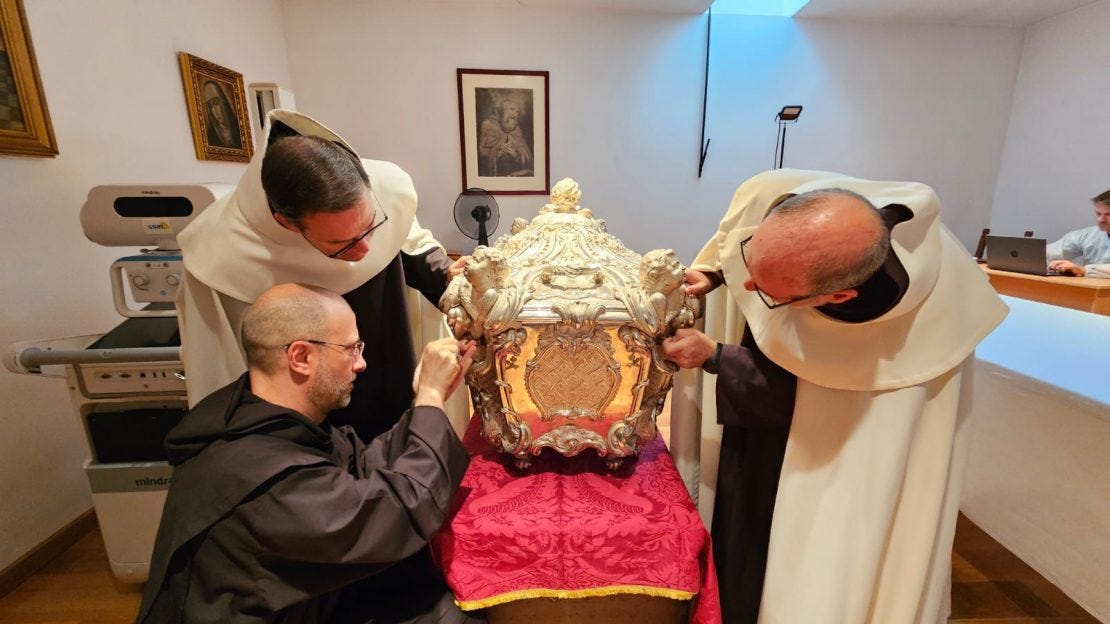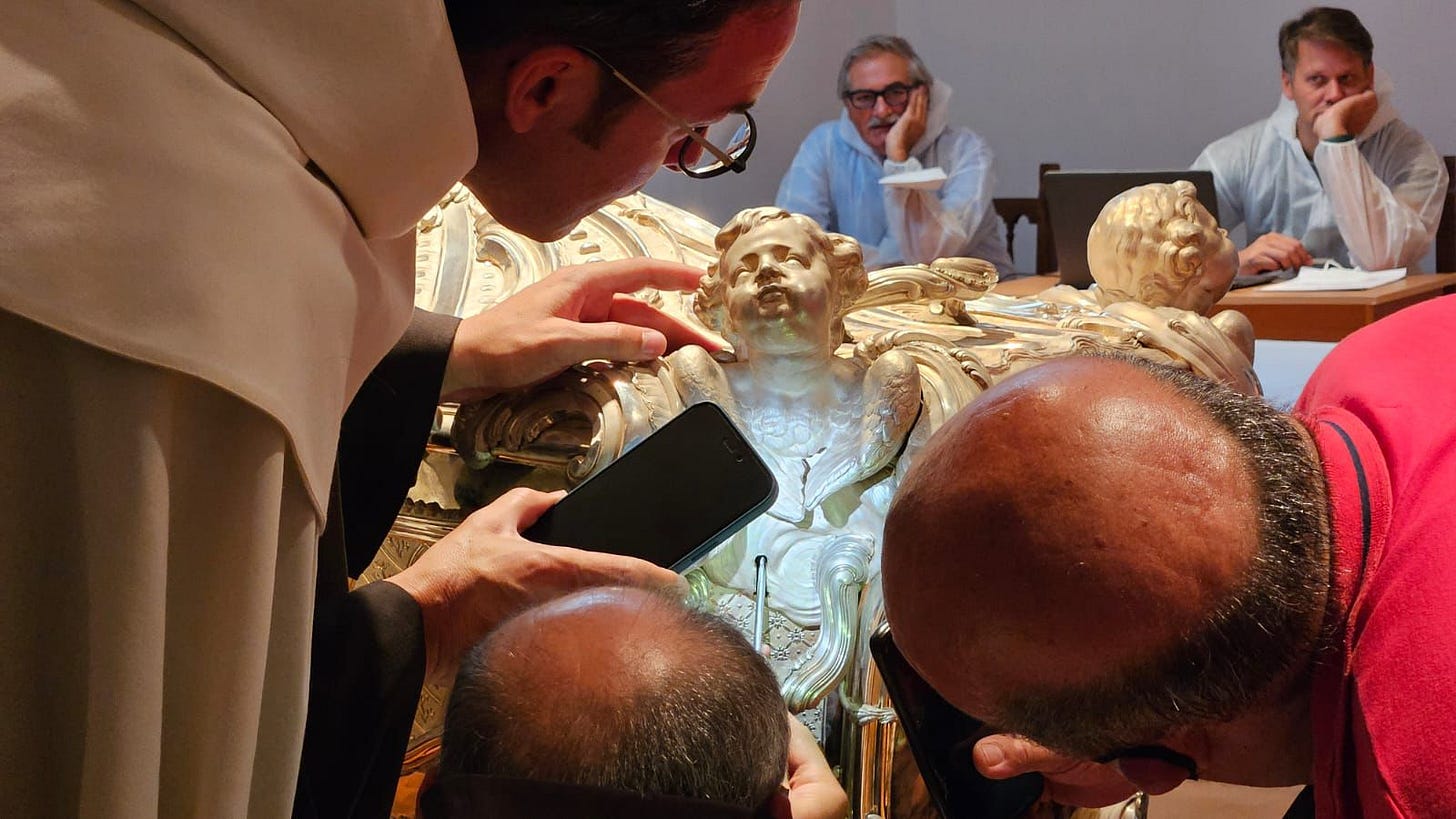St. Teresa of Ávila's Body Remains "Incorrupt" More Than 4 Centuries After Her Death
Scientists, doctors and clergy examined her remains in northwestern Spain after the opening of her coffin.
By Gary Gately
Nearly 450 years after her death, the body of St. Teresa of Ávila — the Spanish nun, mystic, author of spiritual classics and Doctor of the Church — remains incorrupt, showing no signs of decomposing.
The opening of her silver coffin at the Carmelite Monastery of Alba de Tormes in the Diocese of Ávila in northwestern Spain revealed that St. Teresa's body has been preserved from normal decay after death, as it had been the last time the coffin was opened in 1914, the diocese said.
The Catholic Church describes an incorrupt body as one that has avoided the natural process of decomposition after death and instead appears to have been divinely preserved.
“Today the tomb of St. Teresa was opened and we have verified that it is in the same condition as when it was last opened in 1914,” said the postulator general of the Discalced Carmelite Order, Father Marco Chiesa of the Carmelite Monastery of Alba de Tormes, where St. Teresa's remains rest.
In a statement made through the postulator general of the Order of Discalced Carmelites, Father Chiesa said that even though the photos from the 1914 exhumation are black and white, the newly uncovered parts of Teresa’s remains — the face and the foot — are identical to the century-old images.
“There is no color, there is no skin color, because the skin is mummified, but you can see it, especially the middle of the face,” he said. “The expert doctors can see Teresa’s face almost clearly.”
After removal of the marble slab of the sepulcher of St. Teresa’s tomb, the silver coffin was opened under the watchful eyes of the team of Italian doctors and scientists and three members of an ecclesiastical court.
With the opening of the coffin, Italian doctors and scientists will now study St. Teresa's body, heart, an arm and a hand.
Pope Francis, through the Dicastery for the Causes of Saints, granted a July 1 request from Bishop José Luis Retana of Ávila to examine the relics of Saint Teresa.
Chiesa said that the researchers sought to determine that St. Teresa’s body is still incorrupt and to investigate her health before her death.
She suffered numerous health ailments, including painful bone spurs on her feet that in her later years made walking almost impossible.
“But she walked,” Father Ciesca said. “She arrived at Alba de Tormes and then faced death, but her desire was to keep moving forward, despite her physical limitations.”
St. Teresa died in 1582 at age 67 and was canonized in 1622. Pope Paul IV elevated her to Doctor of the Church in 1970, the first woman to receive that honor. (Three other women have since been designated doctors of the Church.)
Some of St. Teresa’s remains have been dispersed throughout Europe as holy relics, but the rest of her body, including her heart and an arm, are at Alba de Tormes in Ávila.
A relic of one of St. Teresa’s hands has been moved nearly 400 miles from Ronda, a town in southern Spain.
The Vatican requires that the investigation of the relics does “not harm, damage or diminish in any way” their “integrity” and imposes strict protocols for the study of the relics.
It began with “in situ” — the opening of the tomb and the vessels containing the heart, the arm and the hand that arrived from Ronda. Two goldsmiths assist with this process.
The opening of the tomb took place in a locked room in a convent with the three members of the ecclesiastical tribunal.
Then a team of specialists will conduct visual examinations, take photographs and X-rays and clean the vessels containing the relics.
The relics will be transferred to Italian laboratories for several months of study, then returned to Alba de Tormes.
Getting into the tomb is no simple matter.
It takes 10 keys, three held by the Alba de Tormes community, three by the Duke of Alba in Eastern Spain, three by the Jesuit father general in Rome and one by the king of Spain, Felipe VI.
St. Teresa, the daughter of a Jewish convert and his second wife, was born in Ávila on March 28, 1515.
After the death of her older brother and her mother and recovery from her own serious illness, Teresa decided to enter the Carmelite monastery of the Incarnation at Ávila. When her father strenuously objected, she fled home and professed her vows in 1537.
She once again fell gravely ill, and fellow nuns prepared for her funeral but she surprised them when she returned to full health.
Teresa loved reading, poetry, music and writing but suffered continuing bouts with illnesses, doubts and self-recrimination.
She ultimately found strength in the power of prayer and contemplation and recounted numerous visions and mystical experiences, including levitating and having her heart pierced by an angel’s spear of divine love. (Italian sculptor Gian Lorenzo Bernini captured that vision in Ecstasy of Saint Teresa, displayed at the Cornaro Chapel of the church of Santa Maria della Vittoria in Rome.)
But Teresa’s visions alarmed some, including confessors who wondered whether she was suffering demonic illusions.
A Jesuit priest who became her spiritual director, St. Francis Borgia, reassured her of the divine inspiration of her thoughts and visions.
Teresa played a major role in restoring Carmelite life to austerity, insisting nuns return to withdrawing from society so they could better focus on prayer and penance.
She opened the first convent of the Carmelite Reform in 1562 with Pope Pius IV’s authorization, demanding poverty and subsistence only through public alms. She went on to found 16 other Carmelite monasteries.
St. Teresa’s “Interior Castle” is considered a spiritual masterpiece. In the book, she traces the journey of a soul through seven chambers or “mansions,” finally finding peace and divine communion with God.
‘While I was beseeching Our Lord today, I began to think of the soul as if it were a castle made of a single diamond or of very clear crystal, in which there are many rooms, just as in Heaven there are many mansions,” St. Teresa wrote in the book.
Her “Autobiography” and “The Way of Perfection” are also considered spiritual classics.
St. Teresa of Ávila, In Her Own Words
“Let nothing disturb you,
Let nothing frighten you,
All things are passing away:
God never changes.
Patience obtains all things.
Whoever has God lacks nothing;
God alone suffices.”
“Christ has no body now but yours. No hands, no feet on earth but yours. Yours are the eyes through which he looks compassion on this world. Yours are the feet with which he walks to do good. Yours are the hands through which he blesses all the world. Yours are the hands, yours are the feet, yours are the eyes, you are his body. Christ has no body now on earth but yours.”
“To reach something good, it is useful to have gone astray.”
“But always when I was without a book, my soul would at once become disturbed, and my thoughts wandered. As I read, I began to call them together again and, as it were, laid a bait for my soul”
"May today there be peace within. May you trust God that you are exactly where you are meant to be. May you not forget the infinite possibilities that are born of faith. May you use those gifts that you have received, and pass on the love that has been given to you. May you be content knowing you are a child of God. Let this presence settle into your bones, and allow your soul the freedom to sing, dance, praise and love. It is there for each and every one of us."
“Remember that true humility consists in being ready for what the Lord wants to do with you and happy that he should do it, and in considering yourselves unworthy to be called his servants.”
“Imagine that this Lord Himself is at your side and see how lovingly and how humbly He is teaching you – and, believe me, you should stay with so good a Friend for as long as you can before you leave Him. If you become accustomed to having Him at your side, and if He sees that you love Him to be there and are always trying to please Him, you will never be able to send Him away, nor will He ever fail you. He will help you in all your trials and you will have Him everywhere. Do you think it is a small thing to have such a Friend as that beside you?”
“Pay no attention to the scarecrows the devils set up in order to cause fear. We should know that each time we pay no attention to them they are weakened, and the soul gains much more mastery.”






